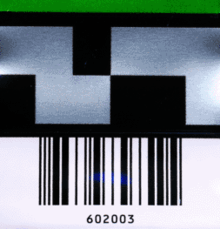DX number

The DX number was assigned by the International Imaging Industry Association (I3A). It uniquely identifies the type and manufacturer (sensitizer) of a film emulsion. A proprietary list of DX numbers for APS and 135 film was prepared yearly or as needed. (DX Codes for 135-Size Film, 2004, I3A; last edition was from January 2009). The list was available for sale from the I3A.
DX number composition
A DX number has two parts separated by a dash: the "combination code" also known as "DX Number Part 1 " followed by a "specifier number", or "DX Number Part 2". For example, Agfa Perutz 3-color 200 ISO film is assigned 115-4 (I3A).
DX barcode
For 135 film cartridges the DX number is hashed to produce a four digit code. A suffix digit for the number of exposures and a manufacturer's proprietary prefix digit are concatenated to form a 6 digit decimal code. The code is printed in human-readable text and also represented as an Interleaved 2 of 5 barcode. Size and position conform to the ANSI/NAPM IT1.14:1994 standard.
To generate digits 2 through 5, the combination code is multiplied by 16 and added to the specifier number. The result is prefixed with zeroes to make 4 digits. For the Agfa film 115-4 above, the digits would be 1844 (16 × 115 + 4).
Digit 1 is any digit from 0 to 9 and is assigned by the manufacturer.
Digit 6 is a code digit for the number of full-frame exposures: 1 is for 12 exposures, 2 for 20 exposures, 3 for 24, 4 for 36, 5 for 48, 6 for 60, 0 for 72 and 7 for non-standard lengths such as 24+3.
The barcode is located between the electrically-read silver and black DX Camera Auto-Sensing Code and the film cartridge exit lip.
The barcode is optically scanned by many film-processing machines when the cartridge is inserted for developing. (Kodak patent 5761558)